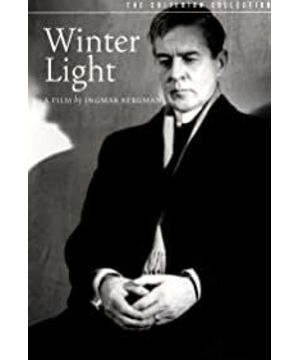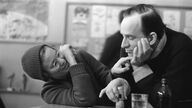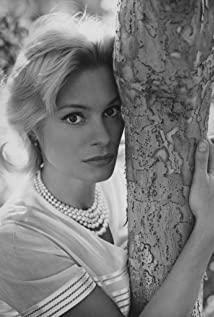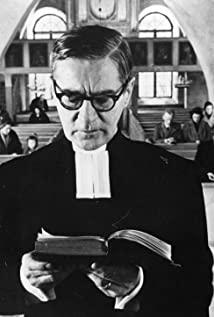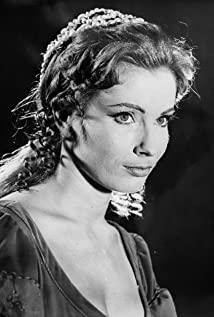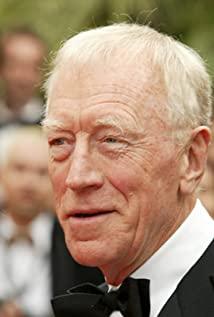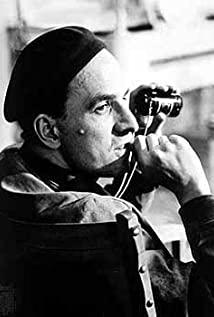"Winter Light" maintains the characteristics of Bergman's "indoor drama". The relationship between the characters is simple, the story structure is single, the interior is the main feature, the dialogue is long, and the main characters are full of hearts. However, I have always felt that the singularity of indoor theater scenes does not mean that the pictures or shots are monotonous. In Bergman's films, some detailed processing makes the scenes of the indoor drama and the delicate inner performances of the characters contrast each other, which not only increases the level and content of the picture, but also enriches the expression of the theme. In "Winter Light", such a detailed element is none other than "light".
The story of the whole movie takes place on a winter day in Sweden. The latitude is high. It will be dark less than 3 o'clock because of the snow and the gloomy weather. The two shots that set the tone are from 2 minutes 26 seconds to 2 minutes 40 seconds (CC area version). The gloomy snowfields, the big trees full of birdhouses, and the icy river channel reflect the unknown origin. Light. And 1 hour, 8 minutes, 50 seconds, 1 hour, 9 minutes, 15 seconds, a long shot of the priest and his lover in the car, the camera meticulously captured the sky at dusk in the extreme daylight area. Then the two went to the exterior scene of the second church. The gray tones were extremely rich, comparable to the most beautiful passages in "Homesickness". In these limited outdoor scenes, the sense of light is a kind of desolation, with the tone of immortality.
The delicate light in the interior scene is especially impressive for the master's passing away.
In the first combined segment, the church's light comes from windows on all sides, and the figures are somewhat dim shadows. In the section of receiving the Eucharist, the light on the face of the character comes from above, which is bright and clean, indicating the false light of God. At 10 minutes and 37 seconds, an old man was standing in front of the window. Light came in from the outside. The light and shadow on the window sill were mottled, and raindrops could be seen sliding down on the window! Pay attention, you can see it in a high latitude winter day with rain and sunshine at the same time. At 13 minutes and 53 seconds, the priest crouched on the window sill, and the window sill was mottled with light and shadow. Later, in the second and fourth combined sections (the priest and the fisherman talk) in this room, the light sources all came from this window, and they were used quite neatly.
The more powerful part is that at the end of the fourth combination segment, starting at around 43 minutes, the pastor stood in front of the window with a close-up with a chest, pushed it into a big close-up, and then pulled it into a small close-up, the light gradually brightened. It didn't seem to be easy to understand at first, and then we discovered that it was the sun coming out, so the light became brighter. The priest also glanced out the window. The change in the light slightly mocked the priest’s faith: after feeling that God had abandoned himself and confirmed the loss of faith, the sunlight appeared... At
44 minutes and 8 seconds, the sunlight passed through the glass and shone on the heroine’s face. . For 44 minutes and 17 seconds, the light pierced into the darkness and was faintly visible. The light becomes the protagonist of this combined segment. The priest walks through the aisle, and the light shines in from the tall arch windows. It is the light of faith and the light of doubt. It has a bit of "unkindness". He expressed his doubts, in the sun, he said he was free, but he did not.
The death of the fisherman immediately faded the sun. In the next combination segment, the stream roared, drowning the inner voice. More importantly, we saw snowflakes flying all over the sky, and at the same time, there was still a faint sunlight on the river. The images and audio in this section were quite violent. It heralds the violent rage of the next combination segment (school quarrel) and another kind of thirsty in the pastor's heart after losing his faith and gaining freedom.
In the next combination segment (visiting fisherman's wife), the most important scene takes place on the stairs in the foyer. The priest's pregnant wife falls into calm pain under the illumination of the top light source. This is the third image who struggles between faith and doubt after the pastor and the fisherman, so it enjoys the same use as the pastor.
Next, around 1 hour, 8 minutes and 50 seconds, the priest walked through the gloomy courtyard of the fisherman’s house. There is a detail that is easy to overlook: outside the door, a pool of water reflects the setting sun, like a movie screen, how can you not go through the darkness. .
In the last combined segment, 1 hour and 11 minutes, we saw the most common candlelight in movies of the same subject. In "Homesickness", a symbol of belief in candlelight. Here, the candlelight is ambiguous, and it seems to refer to weak beliefs (or inferior products). In this section, we can also enjoy the picture of the heroine sitting on the bench where the window is the only light source, and the profile of her profiled by the light. In fact, love cannot be faith, love is doubt, and faith is also doubt. .
After the service began, we had the last set of light effects, with very strong mocking colors, the candles in the lamps were lit, the church was lit, and solemn music played. In an age when beliefs are doubted, what attitude should we use to stick to it?
In "Winter Walk", many scenes are switched using the classical technique of "melting", which is not very popular in art films, and it should also be used to match the changes in light and shadow.
View more about Winter Light reviews


